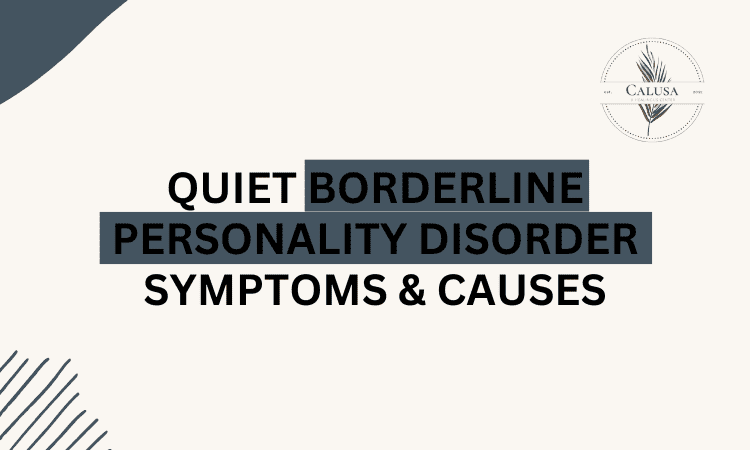The notion of Quiet Borderline personality disorder can at times, be misconstrued for being self-contained rather than being a true type of BPD. The symptoms or any sort of distress in people with Quiet BPD are not apparent, but they are present. The recent article will help readers understand all the aspects related to the symptoms & causes of this condition.
The Quiet Pain of BPD Can Be Overcome!
What is Quiet Borderline Personality Disorder?
Quiet Borderline Personality Disorder is when instead of outside, therapy and encouragement are internalized. They may feel emotions, but instead of showing them, they may act in a way that people would not suspect that something is going on. This may lead the individual in a position where they are unable to obtain the required assistance.
Some of these Quiet Borderline Personality Disorder causes, symptoms, and causes are common because the retrained condition is the focus of the disorder. These signals are important to recognize as they help people or individuals who do not express themselves loudly but are quite sick inside.
Quiet Borderline Personality Disorder Symptoms
They include but are not limited to Dissociative symptoms, Valve symptoms, or significant mood fluctuations in quiet BPD patients. Quiet BPD symptoms can vary, but here are some of the most common:
- Emotional Suppression: Individuals diagnosed with Quiet BPD may out of necessity suppress their emotions. On the outside, they seem calm but on the inside, they are in intense emotional turmoil.
- Self-Blame: People can take the whole blame for whatever is wrong, even if they are not responsible.
- People-Pleasing: In order to appease others and to avert any arguments they may, at times, indulge in acts at their own expense.
- Isolation: They tend to avoid such situations as they feel that they do not deserve people’s love and attention.
- Fear of Abandonment: Even when they do not say it out loud, it is a pretty common fear.
- Mood Swings: While these could happen internally, it is possible for ‘mood swings’ to be unsynchronized with outer behavior.
- Negative Self-Image: They do not have a good self-image and might indulge in self-criticism.
- Avoidance: Avoiding circumstances that are likely to cause emotional distress is common.
These symptoms may be subtle and can be attributed to other disorders or the personality of an individual. However, a right understanding of Quiet Borderline Personality Disorder Symptoms & Causes can help in applying the correct measures in a patient’s life.
Causes of Quiet Borderline Personality Disorder
Several factors can contribute to the development of Quiet BPD:
- Genetics: It is often seen that a family history of BPD or other mental illnesses predisposes you.
- Childhood Trauma: Harsh abuse neglect, or loss during formative years can contribute to Quiet BPD.
- Environmental Factors: Stressful situations such as negative relationships or frequent fights can be stimulants.
- Personality: Quiet BPD may develop in those who are more sensitive or emotional than others.
Comprehending the common risk factors concerning Quiet Borderline Personality Disorder Symptoms, & Causes is crucial, especially for those wishing to control or cure the problem. Those factors are usually interrelated and it is not easy to identify any one factor, but with knowledge comes better management.
Understanding Quiet Borderline Personality Disorder
Diagnosis of Quiet BPD is not easy because it is a deep-seated ailment. Nonetheless, the following signs should be looked at
- Unexplained Mood Changes: Out-of-the-blue changes in emotions at times for no obvious reason.
- Overthinking: Such concerns of what will happen worse create more analysis than action calls for.
- Guilt: Taking responsibility for things that shouldn’t concern them in the least occurs frequently.
It is often the case that symptoms of Quiet BPD are overlooked because they can be harder to detect when dealing with close friends and family or close loved ones themselves. Sad but true, people are likely to even diagnose someone with active BPD despite the prevailing set of Quiet Borderline Personality Disorder Symptoms, & Causes.
Managing Quiet Borderline Personality Disorder Effectively
Managing Quiet BPD is more comprehensive than it seems at first::
- Therapy: The effectiveness of pharmacotherapy, cognitive-behavioral, or manager therapy can be evidenced by the data and the results of studies.
- Self-Care: Most women will pick up some self-care measures such as exercise, meditation, and hobbies, which alleviate some of the symptoms.
- Support Groups: Receiving relief from sharing one’s pain with other people who understand the disease, recovering from verbal abuse and other traumas.
Addressing Quiet Borderline Personality Disorder Symptoms, & Causes is never one dimensional. Owing to the scope of this disorder, anti-therapeutic measures, together with other dependent forms of therapy or social support must also include taking care of oneself.
The Importance of Early Intervention
Early intervention is important when treating Quiet BPD. It is obvious that the sooner the disorder is identified, the better the chances of improving it.
- Seeking Help: You are proactive about seeking help when you readily notice these symptoms in you or your loved one.
- Building Awareness: Raising awareness about the symptoms of Quiet Borderline Personality Disorder.
- Personality Disorder Symptoms, & Causes must be changed for a more positive perspective.
The immediate step taken to instill some control into the disorder will help prevent unfortunate incidences from happening again and will give the individual coping skills to deal with such issues. The understanding and tackling of Quiet Borderline Personality Disorder Symptoms, & Causes like others is done from the center and will thus help in nurturing the prevailing social climate to be more accommodating to the more bereaved.
Your Journey to a Brighter Tomorrow
Conclusion
Quiet Borderline Personality Disorder Symptoms, & Causes needs careful attention as it is usually neglected. It’s shameful, and a tragedy, to ignore people for such a long time due to their PTSD Torch has put out symptoms and treated depression within those who are substantially maladjusted to society. Time is of the essence when it comes to stopping the development of Quiet BPD.
Educating others and self on the Quiet Borderline Personality Disorder Symptoms, & Causes will impact on total wellbeing and build strategies for coping or managing this health condition that may be in obscurity. If that’s you or someone you know, act quickly and get help.
Realizing that these things can be done is the first achievement. If you are amid these experiences to give feedback or looking to help someone who is, knowledge is the first step. Reach out to Calusa Recovery to order help at the very beginning because everybody is entitled to a sympathetic ear and supportive attention. So in order to get your mental peace, at least start it from this place.










